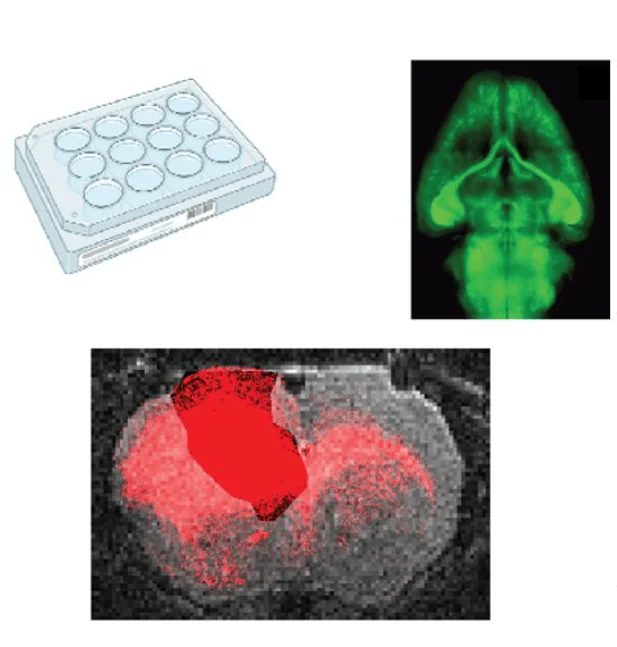Research > Focus A > Work Packages A07
Summary
The contribution of neuron-glioma synapses to resistance against chemo- and radiotherapy will be studied using state-of-the-art imaging technologies that allow for high-throughput screening and analyses of tumor-neuron networks. Molecular determinants of neuron-tumor synapses are analysed through multi-omics in both preclinical models and patient material. We aim to identify if disrupting neuron-tumor synapses can be synergistically used with standard-of-care approaches to overcome therapy resistance.
Task 1
Development and validation of methods to quantify neuron glioma synapses as a cellular mechanism and a biomarker for therapy resistance in gliomas
Steps / Workflow
- Establish high-through-put microscopy methods to quantify neuron glioma synapses in large tissue volumes across cell states
- Compare neuron glioma synapses patient derived xenograft models (+/- radiochemotherapy, +/- AMPAR inhibition) across tumor cell states
- Validate findings based on paired primary and recurrent human glioma tissue samples
Task 2
Functional and molecular characterization of neuron glioma synapses in therapeutic resistance
Steps / Workflow
- Investigate functional communication of neuron glioma synapses with patch clamp electrophysiology and calcium imaging under therapy
- Use scRNAseq , spatial transcriptomics and proteomics to investigate the molecular composition of neuron tumor networks under therapy
Task 3
Pharmacological perturbation of neuron glioma synapses to study effects on tumor resistance.
Steps / Workflow
- Pharmacological in vitro screen in neuron/astrocyte co-cultures in combination with standard-of-care therapy
- In vivo screening of 3 compounds from the in vitro screening by 2-photon imaging, MRI and whole brain lightsheet microscopy
- Determine synergistic effects with combinations of anti neuron glioma synaptic compounds and standard of care therapy

VENKATARAMANI, DR. MED., DR. RER. NAT.
University Hospital Heidelberg, Department of Neurology, Im Neuenheimer Feld 400, 69120 Heidelberg, Germany

KARREMAN, MATTHIA, PHD
University Hospital Heidelberg, Department of Neurology, Im Neuenheimer Feld 400, 69120 Heidelberg, Germany
Address
Im Neuenheimer Feld 400
69120 Heidelberg
Themen
Research
- Focus A
- A01: Targeting tumor cell network communication to overcome primary and adaptive resistance in glioblastoma
- A02: Development of a specific combination therapy for histone H3-mutant pediatric glioblastoma
- A03: Deciphering resistance against targeted treatments
- A04: Elucidating tumor-associated microglia interactions in astrocytomas CNS WHO-grade 4
- A05: Predictive biomarkers for MGMT-promoter-methylated glioblastoma (2019 – 2023)
- A06: Resistance mechanisms of glioblastoma against alkylating agents and radiotherapy
- A07: Mapping and targeting neuron-tumor networks to tackle therapy resistance in glioblastoma
- A08: Personalized glioblastoma treatment guided by patient-derived tumor organoids
Research
- Focus B
- B01: Mechanisms of response and resistance to glioma-specific t cells
- B02: DNA mis-match repair regulates immune checkpoint blockade therapy in glioblastoma (2019 – 2023)
- B03: Targeting immunosuppressive programs in isocitrate dehydrogenase mutant gliomas
- B04: Impact of myeloid cells on the adaptive immune response in newly diagnosed and recurrent glioblastomas
- B05: Dissecting the response of glioblastoma and its tumor microenvironment to focused high-dose radiotherapy (2019 – 2023)
- B06: Visualization and characterization of immune responses in H3K27M mutant gliomas
Research
- Focus C
- C01: Comprehensive preclinical pharmacology testing of drugs used for glioblastoma treatment
- C02: Radiomics, radiogenomics and deep-learning in neurooncology
- C03: Imaging immune signatures of glioma response and resistance towards immunotherapy (2019 – 2023)
- C04: Metabolic signaling in glioblastoma: a spatial multi-omics approach
- C05: Overcoming glioma radio-resistance with particle therapy
- C06: Functional characterization of EGFR structural variants associated with long-term survival in glioblastoma, IDH-WT




